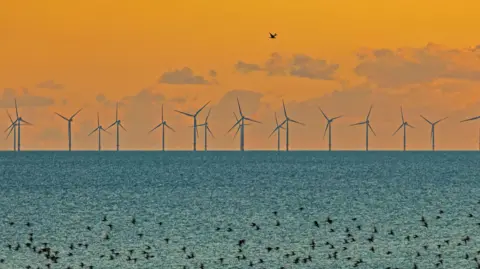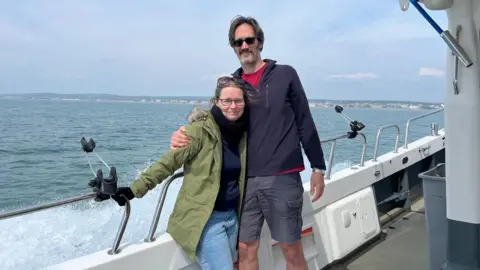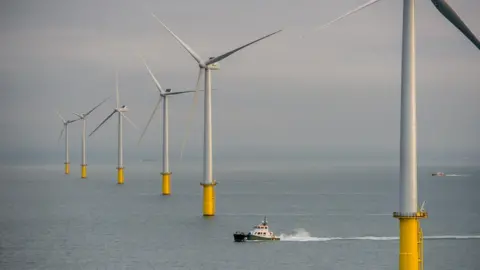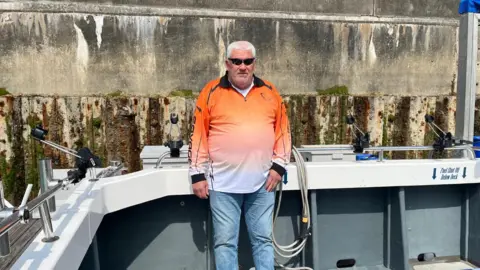Wind turbines power 'surprising' tourism boom
 Getty Images
Getty ImagesWhen Rampion windfarm was first proposed off the Sussex coast, concerns were raised that it would decimate local tourism.
Critics claimed the large white structures would spoil views from areas like Brighton's iconic beach and the South Downs National Park, ultimately deterring people from visiting.
But, for some, the opposite has been true.
Tim Nightingale, who was on a tour of Rampion with his wife Peggy, said he wanted to visit the windfarm as it was "unusual".
"It is something you would not normally see or experience," he told the BBC.
Though she suffered seasickness, Ms Nightingale added it was fun to get up close to such "massive" turbines and hear the swooshing of the blades.
The couple from Rustington, West Sussex, said the tours had an important function, in that they could shift people's stance on renewable energy.
 Joshua Askew/BBC
Joshua Askew/BBCMs Nightingale said: "Rampion got a lot of bad press because some people hate the look of them [wind turbines].
"But I think coming to see them up close might make people think, you know what, they're actually really beautiful, graceful and technically amazing."
"Let's keep them. Let's have more."
Rampion, named after the county flower of Sussex, is home to 116 wind turbines which are 140m (460ft) high to the blade tip.
Opened in 2018 at a cost of £1.3bn, the site generates enough clean, low carbon energy to power 350,000 UK homes.
Plans to expand the windfarm by a further 90 turbines - which could be more than twice as high at up to 325m (1,066 ft) - were approved in April.
'Photogenic'
Dr Adam Jones, principal lecturer of strategy and marketing at the University of Brighton, told the BBC several factors were fuelling turbine tourism.
Alongside the rise of the staycation, he said people were increasingly seeking that TikTok or Instagram moment as the turbines were "photogenic".
Dr Jones added that as tourist hotspots like Brighton get more saturated new activities were emerging to "reinvigorate" the destination.
He told the BBC small and medium-sized businesses were gaining the most from the phenomenon.
"It is not big tours - it's actually local fishermen that are benefiting," he said, adding that it was a "good way" of spreading opportunity.
 Rampion
RampionPaul Dyer, who runs Brighton Diver, an agency taking people on a boat to see the turbines, said the tours were "surprisingly popular" - especially with residents.
He told the BBC one reason behind this popularity was curiosity, given that Rampion is located near a densely-populated area.
"Millions of people are looking at it out their window every day," he said.
Mr Dyer, who started his tour business six years ago, is one of several firms operating from Brighton Marina, running regular trips to the site, which is about eight miles out to sea.
Operators also bring people to the Kentish Flats Offshore Wind Farm in Thanet, Kent, which was once the largest windfarm in the world, according to it's Swedish owner Vattenfall.
Fishing trips at the windfarms in Kent and Sussex are also becoming popular.
Evidence suggests the sites can act as artificial reefs which help to protect marine life, especially as trawling is typically not allowed near the area.
 Joshua Askew/BBC
Joshua Askew/BBCMr Dyer added the tours helped people learn about the Rampion windfarm - one of the largest in the UK.
"A lot of people don't really understand what the farm does. They think it takes one turbine to power a kettle," he joked.
"But once you explain it to them, and they realise all that goes into it and what it does, they're quite impressed."
Follow BBC Sussex on Facebook, X and Instagram. Send your story ideas to [email protected] or WhatsApp us on 08081 002250.
